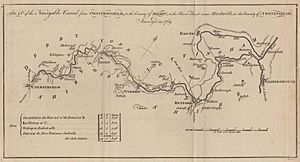John Varley (canal engineer) facts for kids
John Varley (born June 8, 1740 – died February 16, 1809) was an important English engineer. He was born in Heanor, Derbyshire. John Varley is best known for building the Chesterfield Canal. He passed away in 1809 and is buried in Harthill, Derbyshire.
Contents
Early Life of John Varley
John Varley was born on June 8, 1740. His parents were Francis and Rebekah Varley. He grew up in Heanor, Derbyshire. In 1770, he married Hannah Pattern.
Starting in Canal Building
John Varley began his career working with James Brindley. Brindley was a very famous engineer. Varley helped survey a planned canal from the River Don to Cinderbridge.
Building the Chesterfield Canal
John Varley and James Brindley worked together to plan the route for the Chesterfield Canal. They thought it would cost about £94,908 to build. Brindley shared their plans at a meeting in Worksop in 1769.
The idea for the canal was approved by Parliament in 1771. Many important people supported the project. This included the Duke of Devonshire and the Duke of Newcastle. They formed a company to build the canal. They planned to raise £100,000 to pay for it.
Construction of the canal started right away. James Brindley was in charge. When Brindley passed away in 1772, John Varley took over as the main engineer. Hugh Henshall, Brindley's brother-in-law, became the Chief Engineer in 1773.
The canal was first planned to be a "narrow canal." This meant it would only fit smaller boats. But in 1775, some people offered to pay extra. They wanted a "broad canal" from Retford to Stockwith. This would allow bigger boats to use that part. The extra cost was over £6,000.
The entire canal opened in 1777. It was about 46 miles (74 km) long. It had 65 locks, which are like water elevators for boats. It also had two tunnels. One was short, about 154 yards (141 meters). The other was the Norwood Tunnel, which was very long at 2,880 yards (2,634 meters). At the time, Norwood Tunnel was one of the longest canal tunnels in Britain!
The Chesterfield Canal was built to follow the natural shape of the land. This helped avoid expensive digging or building high banks. This made the route less direct in some places.
At first, the canal was very successful. But later, a railway line was built next to it in 1849. This made much of the canal less useful. The part from Worksop to Chesterfield stopped carrying goods in 1908. This was because of problems from mining that caused the Norwood Tunnel to collapse. Parts of the canal near Chesterfield were filled in and built over.
Later Years and Other Projects
The Canal Company asked John Varley to build a house. It was near the east end of the Norwood Tunnel. This house became known as Pennyholme. John Varley and his family lived there for many years.
Varley also worked on other canal projects. He was the engineer for the Erewash Canal. He also surveyed the routes for the Nutbrook Canal and the Leicestershire Line.
John Varley died at Pennyholme on February 16, 1809. He was buried in Harthill Parish Churchyard.
Remembering John Varley
John Varley is one of the important people from the early Industrial Revolution who is sometimes forgotten. The Chesterfield Canal Trust remembers his work. They have named one of their canal trip boats the "John Varley."
In 2009, a special plaque was put up to honor John Varley. This was 200 years after he passed away. The plaque is on the wall of The Old School House in Harthill, near Rotherham.



